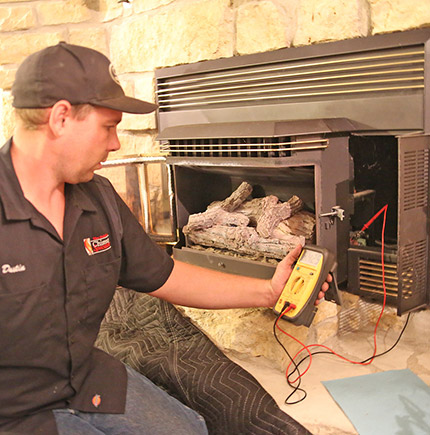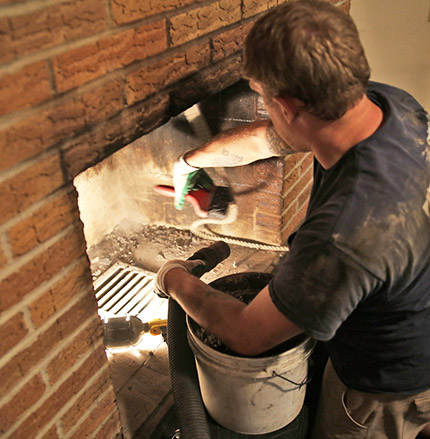Fireplace Safety Tips & Advice – Gas, Electric & Wood Fires
 Making use of your fireplace can be a great way to cut down on your heating costs and create a cozy atmosphere in your home. If you are not careful, it can become a safety risk. Whether you have a gas fireplace, electric fireplace or wood-burning fireplace, it is important to follow a few basic safety tips to prevent the risk of a fire or carbon monoxide poisoning.
Making use of your fireplace can be a great way to cut down on your heating costs and create a cozy atmosphere in your home. If you are not careful, it can become a safety risk. Whether you have a gas fireplace, electric fireplace or wood-burning fireplace, it is important to follow a few basic safety tips to prevent the risk of a fire or carbon monoxide poisoning.
#1 – Replace the batteries in your fire detector & carbon monoxide detector regularly
Taking the time to check the batteries in your fire detector and carbon monoxide detector once a month could save your life. Carbon monoxide (C0) is called the silent killer because it is a tasteless, odorless poisonous gas that is produced by appliances that burn fuel like gas and wood fireplaces. Without a functioning carbon monoxide detector, you may only find out your fireplace is leaky CO when it is too late.
#2 – Keep a charged fire extinguisher near the fireplace
Hot embers can jump out of the fire and ignite nearby furniture or drapery. Malfunctioning gas and electric fireplaces can also spark a house fire. Keeping a fire extinguisher nearby could save your life and your home. If your fire extinguisher is not charged, it may fail when you need it most. That is why you should have your fire extinguisher recharged by a professional at least once a year.
#3 – Invest in protective hearth accessories
The space around your fireplace can be a safety risk especially for children. If there are sharp steps or hard tiles around your fireplace, it is smart to invest in a hearth pad. Hearth pads provide a safe cushion for children but are made of fire resistant material that won’t be ignited by a stray spark.
#4 – Check your fireplace for signs of damage
Significant types of damage to your fireplace can make it unsafe to use. There are different types of damage to look out for depending on the type of fireplace you have. If you have an electric fireplace, you should check to make sure there are no worn or frayed wires. If you have a gas fireplace, you should check the gas lines to make sure there are no signs of a leak. If you have a wood-burning fireplace, you should look in the firebox to make sure there are no cracks or pieces of chipped masonry that have fallen down the flue. All of these can be warning signs that your fireplace is not safe to use. If you notice these problems, you should contact a NFI (National Fireplace Institute) Certified Specialist to inspect your fireplace and repair it.
#5 – Open the damper before lighting a fire
The damper is the vent in the chimney that allows smoke to escape outside and fresh air to come in. Before lighting a fire in your fireplace, you should always open the damper so that smoke won’t collect in your home. If you notice that the damper is not opening or closing properly, you should contact a fireplace expert. Breathing in smoke, and potentially CO, from the fireplace can be injurious to your health.
#6 – Extinguish the fire before leaving or falling asleep
Whether you have a gas fireplace or wood-burning fireplace, you should not let it burn while you are sleeping or out of the room. The risk of a house fire increases when you are not able to pay attention to it to ensure it doesn’t get out of control.
#7 – Only burn seasoned, untreated hardwoods
If you have a wood-burning fireplace, it is important to burn the right wood. Unseasoned, or green, wood and softwoods produce more creosote. Creosote is a combustion byproduct that builds up on chimney walls. It is extremely flammable. High levels of creosote in a chimney dramatically increase the risk of a chimney fire. Burning plastic, composite woods and woods that have been painted can be dangerous as well. Due to the chemicals in them, they can release toxic gases when burned that can have a detrimental impact on your health.
#8 – Don’t overload the fireplace with wood
Adding too much fuel to the fire can make it become out of control. If you build a fire with wood in your fireplace, start it small with only a couple of logs. Build it up as needed to maintain control of the fire.
#9 – Invest in an annual cleaning and inspection
 The National Fire Protection Association recommends that homeowners have their chimney and fireplace cleaned and inspected at least once a year. Annual chimney cleanings and inspections have been demonstrated to reduce the number of fireplace injuries and deaths. NFI Certified Specialists are trained to catch problems before they become life threatening.
The National Fire Protection Association recommends that homeowners have their chimney and fireplace cleaned and inspected at least once a year. Annual chimney cleanings and inspections have been demonstrated to reduce the number of fireplace injuries and deaths. NFI Certified Specialists are trained to catch problems before they become life threatening.
You deserve to enjoy your fireplace without fear. Following these 9 fireplace safety tips could save your life and your home from the dangers of a house fire and carbon monoxide poisoning.
If you need to setup a chimney cleaning or inspection to ensure your fireplace’s safety, give us a call! All of our chimney experts are NFI certified with expertise in repairing gas, electric and wood-burning fireplaces.







